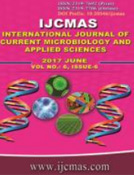


 National Academy of Agricultural Sciences (NAAS)
National Academy of Agricultural Sciences (NAAS)

|
PRINT ISSN : 2319-7692
Online ISSN : 2319-7706 Issues : 12 per year Publisher : Excellent Publishers Email : editorijcmas@gmail.com / submit@ijcmas.com Editor-in-chief: Dr.M.Prakash Index Copernicus ICV 2018: 95.39 NAAS RATING 2020: 5.38 |
Bacteria are ubiquitous in nature. Based on their role bacteria may be grouped as beneficial, spoilage causing and pathogens. The saprophytic group, involved in causing the spoilage of milk and milk products, produce various kinds of surfactants to utilize the milk components. Synthetic surfactants dominate in the market especially in detergent formulations and considered as non-biodegradable and toxic. Biosurfactants are surface metabolites produced by bacteria and fungi having very different chemical structures and properties. Surfactin a lipopeptide biosurfactant is produced by vari¬ous strains of Bacillus subtilis. Surfactin has the surface tension of 27 mN/m and active between pH 5 and 9. It has been preferentially considered for various commercial applications in the dairy industry as the emulsifier, antibacterial agent and in detergent formulations due to its characteristics. Generally used emulsifiers in the dairy industry are lecithin obtained from animal and plant sources having their own limitations. Surfactin is found to be more beneficial over lecithin and possibilities may be explored in the dairy industry.
 |
 |
 |
 |
 |